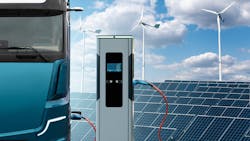The U.S. Securities and Exchange Commission proposed a climate rule in March that would require all publicly traded companies to disclose their Scope 1 and Scope 2 greenhouse gas (GHG) emissions. Scope 1 is related to direct emissions like a fleet of trucks. Scope 2 is related to indirect emissions from acquired energy. In addition to uniform reporting and disclosure, the purpose of the proposed rule is to help companies gauge the overall environmental impact of their business.
There is going to be continued pressure on fleets and shippers to reduce overall emissions coming from regulatory bodies. Battery-electric vehicles are being touted as one solution, and they are a good option for Classes 1-6 trucks. Things get a little less clear when it comes to Class 7 trucks, and Class 8 long-haul trucks will not be moving away from diesel power any time soon.
The right partner can help a fleet measure GHG emissions as well as help develop strategies to reduce those emissions. Fleets need to leverage partnerships that will help them identify which duty cycles make sense for alternative power. Rather than look at a fleet as a monolith, consider viewing it as “fleets within the fleet.”
Most fleets run in a variety of duty cycles, so there is no one-size-fits-all solution when it comes to reducing emissions. For the route-delivery portion of a fleet’s operation, now is the time to look at how electric vehicles can be direct replacements for diesel-powered units. The same is true for yard spotters. However, for the trucks in long-haul applications, the goal needs to be maximizing fuel economy and reducing overall carbon emissions.
Fleets should not fear electrification, as it is not a wholesale change to the fleet’s operation. Instead, the goal is analyzing each segment within the fleet to determine the best way to achieve emissions reduction goals.
When it comes to diesel-powered trucks, consider working with a partner that is an EPA SmartWay affiliate, an organization agreeing to educate and support members’ efforts to improve fleet sustainability. They can guide a fleet through the vehicle specification process and assist them in choosing SmartWay-verified technologies like aerodynamic devices, low-rolling resistance tires, and idle reduction technologies. Fuel savings for these devices vary, but a combination of aerodynamic technologies verified by the EPA to perform at an elite level have achieved a fuel savings of 9% or more.
Today, the EPA says transportation is the largest contributor of GHG emissions, accounting for about 27% of the total in the U.S. As we move into the future, there will continue to be pressure on fleets to reduce their emissions.
All of us in the transportation industry need to do our part to help fleets make the right decisions to ensure a greener future.
Patrick Gaskins, SVP of Corcentric Fleet Solutions, oversees both sales and operations for the company's fleet offerings. Gaskins joined the company in 2010, bringing more than 30 years of experience as a financial services professional in the transportation industry. He leads a team that works with a supply base of more than 160 manufacturers to help the country’s largest fleets manage all aspects of their fleet operations and fleet-related spend.
This article originally appeared on FleetOwner.com.
About the Author

Patrick Gaskins
Patrick Gaskins, senior vice president of Corcentric Fleet Solutions, oversees both sales and operations for Corcentric’s fleet offerings. Over the past 10 years, Gaskins has grown the fleet services area of Corcentric’s business by implementing a best-in-class asset management database and a data-driven approach to providing Corcentric clients with visibility into all areas of their fleet spend. He joined Corcentric in 2010, bringing over 30 years of experience as a financial services professional in the transportation industry. Gaskins leads a team of industry experts who work with a supply base of over 160 manufacturers to help the country’s largest fleets manage all aspects of their fleet operations and fleet-related spend. Gakins earned his BBA in Finance from the University of Miami, Florida, and his CTP certification from the National Private Truck Council.
